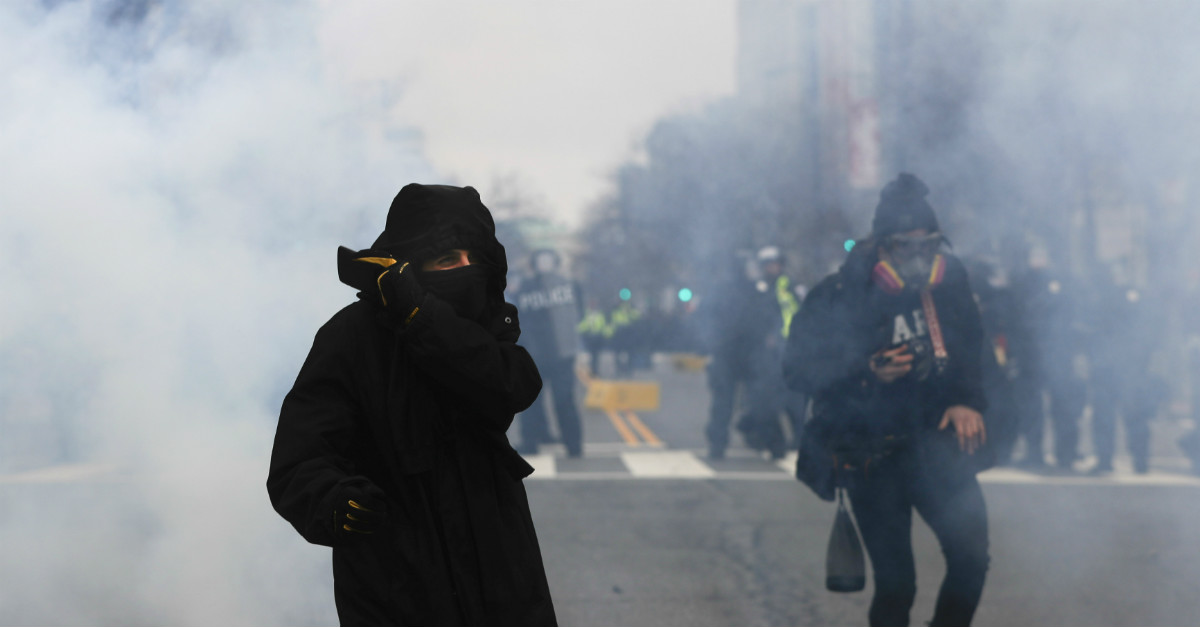There were many things to deplore in Donald Trump’s post-Charlottesville address last Sunday, but his condemnation of violence on “many sides” wasn’t one of them. Yet pundits have spent the past two days wagging their fingers and scratching their heads. In one of the most willfully obtuse pieces of journalism I’ve ever read, Jeremy Peters at the New York Times spent more than 1,200 words angling his decoder ring and quoting conservative commentators, trying to divine what Trump could have possibly meant. He didn’t even mention the word “antifa” without prompting; it took Noah Rothman of Commentary to do that.
Videos by Rare
Forty-five seconds on Google would have given Peters a hint as to what the president was talking about. “Antifa” is short for “antifascist,” and it’s become the signifier for a loosely organized group of black-masked counter-demonstrators who have been attacking Trump supporters and wreaking havoc. Portland, Ore., has become their stomping ground, but they’ve also been involved in violence in California, Minnesota and elsewhere.
Antifa militants have thrown punches, hurled bottles filled with urine and feces, vandalized cars, smashed windows, intimidated cities into canceling pro-Trump displays and forced right-wing speakers off of campuses. After one particularly bloody confrontation in Sacramento during which seven people were stabbed, the police blamed antifa for starting the violence, not the neo-Nazis they were protesting.
RELATED: Donald Trump’s second round of comments about Charlottesville was too little, too late
All this mushroomed into the carnage in Charlottesville last weekend. The bloodshed there, carried out by white nationalist thugs, was in part precipitated by a fear of left-wing violence. As Dave Weigel reports at the Washington Post, the protesters were worried they’d be assaulted by antifa, and that the police wouldn’t protect them. That in no way subtracts from the horror of the domestic terrorism committed that day or the putrid racism on display. But it does alter the complexion of the narrative: there is not just a new wave of white nationalism emboldened by Trump but also its mirror image, antifa black masks, whose prolific record of violence Democratic politicians have done little to shame.
This is the story in our America today: fringe-left and alt-right groups fueling each other and escalating against each other, spilling their hatred offline and in front of the cameras, forcing us all to take notice of two political strands that we’d thought consigned to the dumpster of historical error. Our politics are trapped in a cascade of reaction. The domestic terrorism in Charlottesville was in part a response to prior antifa violence, which was in part a response to Donald Trump’s election, which was in part a response to political correctness, and so on. Both elements have now tried to physically harm the other, citing as an excuse the damage inflicted by the other. Both are surging their in their recruitment efforts.
RELATED: Charlottesville reiterates the insidious nature of racial prejudice and injustice in America
I keep coming back to 1930s Spain for historical comparison, and I’ll do it again now. It was another instance when the left and right radicalized each other, the square for peaceful discourse vanished, and street violence became common. The background is complicated, but thuggery on the left was one catalyst. Historian Antony Beevor wrote of 1934 Spain (on page 182 of this PDF of his book “The Battle for Spain: The Spanish Civil War 1936-1939”), “The most dangerous development at this time was the bolshevization of the socialists led by Largo Caballero.” When bloody strikes broke out, and labor leader Caballero declared, “The revolution we want can be achieved only through violence” (page 255), the existing order — defenders of the aristocracy and the Catholic Church — took it seriously, and militant groups gained prominence. These escalations erupted into a three-year civil war that would kill more than 600,000 and end with Spain under the control of General Franco.
America, of course, is more durable than that. Our institutions are far stronger than Spain’s were at that time, and everyday experience leads most of our people to reject the dehumanizing politics of the extremists. But nothing good ever follows fascists clashing in the streets with Marxists. Those in positions of influence need to unflinchingly condemn the violence — on all sides, yes — rather than pretend it’s been occurring in a vacuum.



